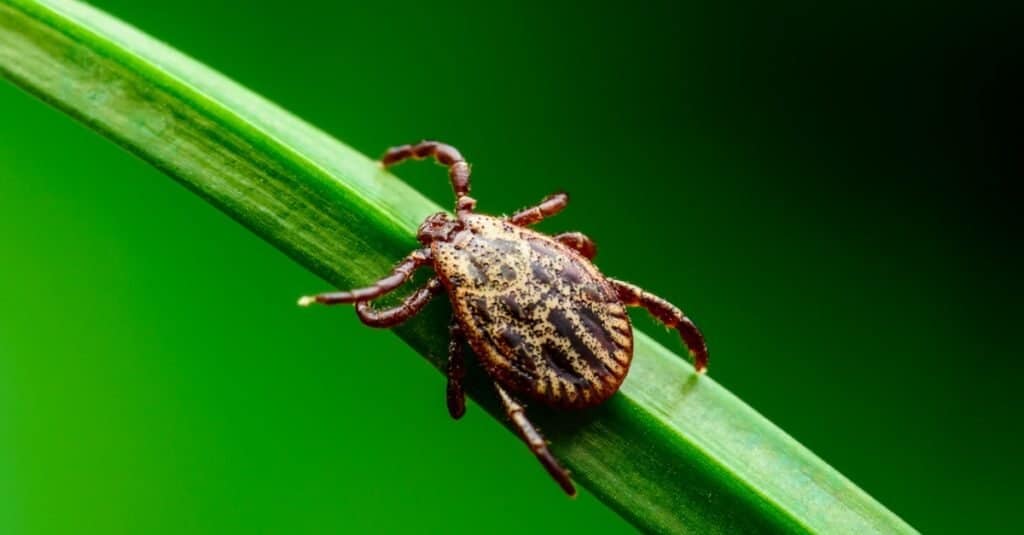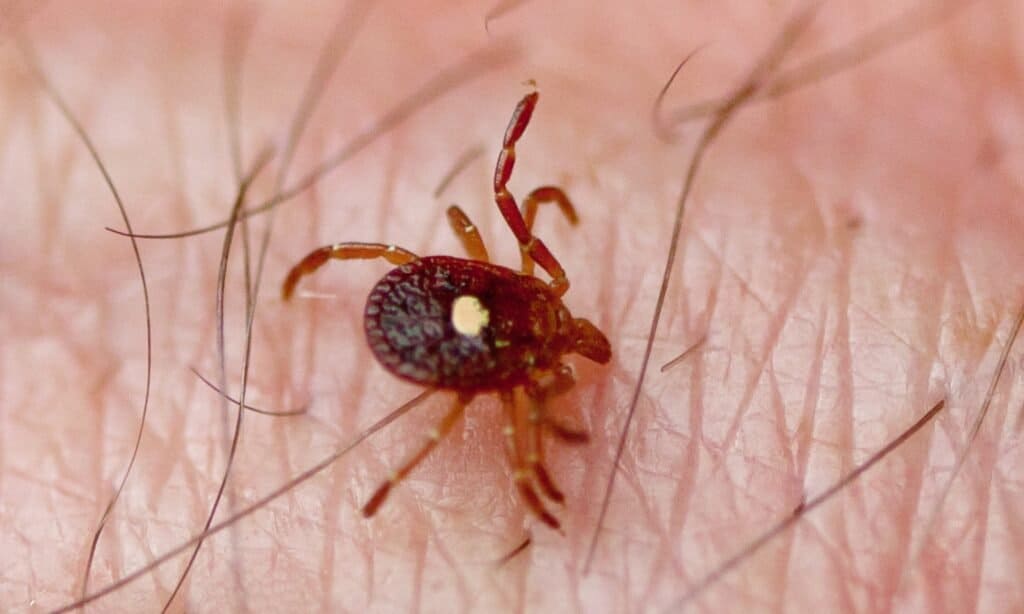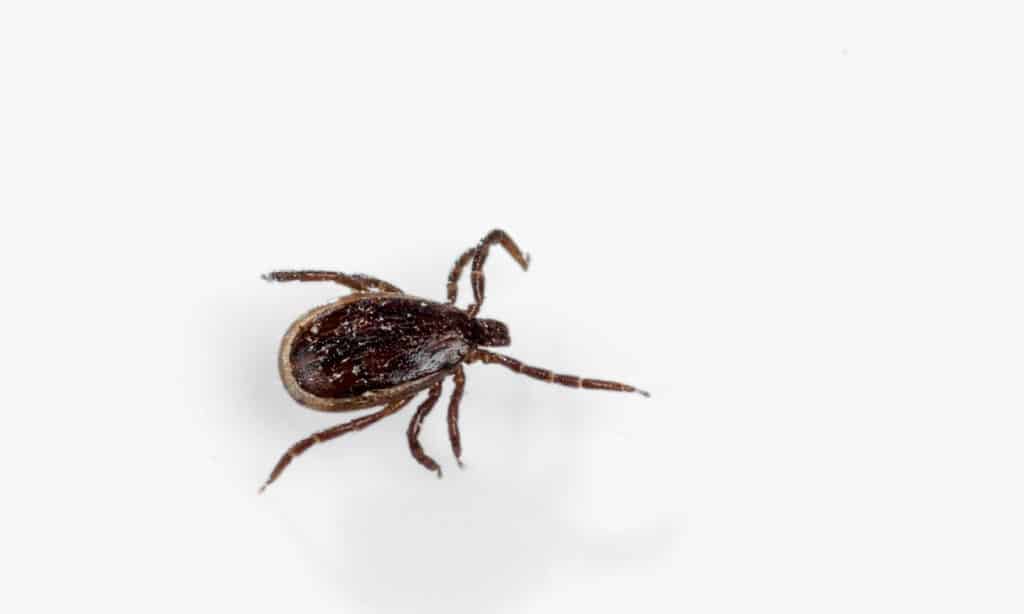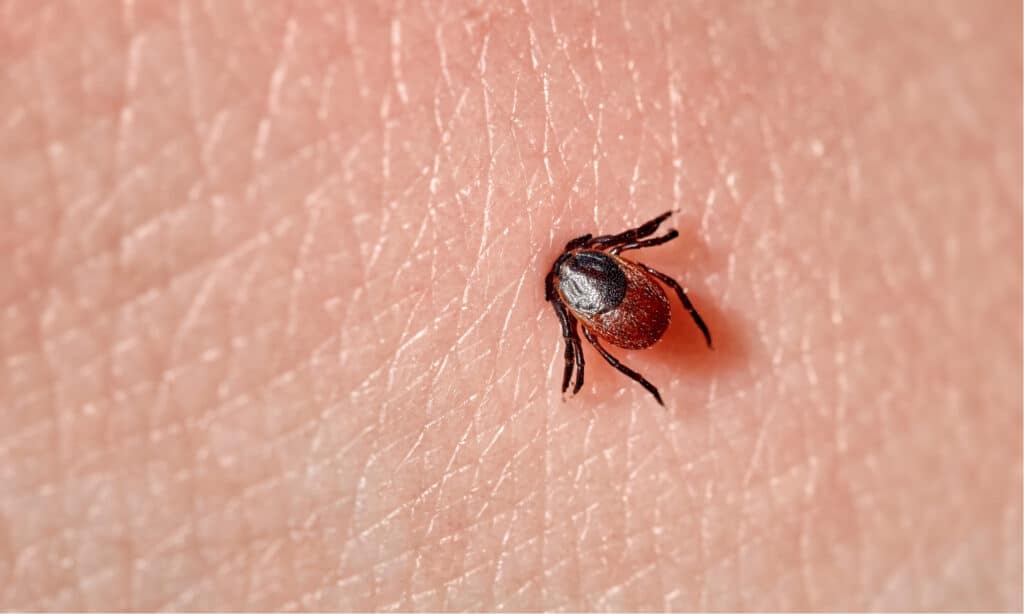North Dakota is home to not just one, but several species of ticks. Of all the ticks in North Dakota, the American dog tick and deer tick are the most common.
All of North Dakota’s ticks are what’s known as ‘hard-bodied’ ticks. They belong to the Ixodidae family, which comprises about 700 species of ticks all over the world. Out of all those ticks, the ticks in North Dakota are among the most prevalent, and one of them is also the deadliest.
Here, we’ll learn about the ticks in North Dakota and which one you need to be worried about. We’ll start by taking a closer look at each species of tick you might encounter in this northern state. Then, we’ll go over the ‘tickiest’ times of the year, and how to avoid ticks in North Dakota.
Ticks in North Dakota
1. American Dog Tick

The American dog tick is the largest of all ticks found in North Dakota.
©iStock.com/nechaev-kon
American dog ticks are the most common type of tick encountered in North Dakota. The easiest way to differentiate them from other ticks is by their size. American dog ticks are closer to the size of a dime than any other tick. They can also be identified by their tan and brown mottling and red-brown legs. Both males and females have large, easily visible mouthparts.
American dog ticks (also known as wood ticks) primarily bite dogs and other medium to large mammals. They’re the primary vectors for Rocky Mountain spotted fever, which they can spread to humans through their bite.
2. Lone Star Tick

Only a few lone star ticks have been recorded in North Dakota.
©iStock.com/epantha
Lone star ticks aren’t common in North Dakota; they’ve only been found in a handful of counties. They’re smaller than American dog ticks but have larger mouthparts. Females have a white spot on their back, making them easy to identify. Males lack the spot and have all-over tan and brown mottling. Both male and female lone star ticks have red-brown legs.
Lone star ticks feed off of prey of any size, including squirrels, rats, mice, raccoons, foxes, coyotes, deer, dogs, and humans. They’re the primary vectors for human monocytic ehrlichiosis, but they do not carry Lyme disease.
3. Winter Tick

The winter tick is one of the only ticks to remain active in the winter months.
©iStock.com/VladK213
Winter ticks are small, with oval bodies and red-brown legs. Females have red-brown bodies with tan scuta (the rounded shield-like structure over the shoulders). Males are all-over mottled tan and red-brown. These ticks in North Dakota are known as ‘one host’ ticks because they feed off of only one animal for all three of their life cycles. This is unlike other species of tick, which take at least one host per life cycle.
Winter ticks only rarely bite humans. Instead, they prefer the late fall and winter blood of large animals, like deer, elk, and moose.
4. Deer Tick

The deer tick is the only tick in North Dakota capable of transmitting Lyme disease.
©KPixMining/Shutterstock.com
Also known as the black-legged tick, the deer tick is perhaps the most common, and the most worrisome of all ticks in North Dakota. Deer ticks are easily recognized by their black legs, a trait not shared by any of the other ticks in North Dakota. Females have distinct red-brown bodies with black scuta. Males have all-over dark bodies with black legs.
The deer tick is the only tick capable of spreading Lyme disease to humans. If you find a deer tick embedded in your skin, remove it immediately and use rubbing alcohol to kill it. Then, send the deceased tick off to the lab for Lyme disease testing and consult your primary care physician.
5. Brown Dog Tick

Of all the ticks in North Dakota, only the brown dog tick lives indoors.
©iStock.com/Goldfinch4ever
The brown dog tick is the only type of tick in North Dakota to live, not outdoors, but indoors. Brown dog ticks feed almost exclusively on the blood of canines and can be found anywhere that houses dogs. They will also occasionally feed on humans, or even cats.
Brown dog ticks have narrow, red-brown bodies with small mouthparts. Males and females look very similar. They are vectors for dog-specific diseases in case of bites to canines and may also transmit Rocky Mountain spotted fever to human hosts. Unfortunately, these ticks are found just about everywhere there are dogs.
When is Tick Season in North Dakota?
For most ticks in North Dakota, active season starts in late spring and ends in early fall. The exceptions to this seasonality are the winter tick and the brown dog tick. Winter ticks are generally encountered on big game in the fall and winter, while brown dog ticks may feed on dogs year-round.
Do Ticks in North Dakota have Lyme Disease?
In North Dakota, only the deer tick and the black-legged tick carry Lyme disease. The best way to avoid contracting Lyme disease is to take precautions against tick bites. And, if a bite does occur, always remove the tick as soon as possible.
How to Avoid Ticks in North Dakota

Ticks are parasitic arachnids closely related to scorpions, spiders, and mites.
©Evgeniyqw/Shutterstock.com
Ticks in North Dakota are best avoided by wearing light-colored clothing treated with insect repellent. Light colors make it easier to spot ticks. The bug spray should never be used directly on your skin; only on your clothes. Further, your best option is to choose long-sleeved shirts and long pants. Ticks cannot bite through clothing, and ticks can’t jump or run either.
If you’re planning on going for a hike, try to stay out of areas with dense underbrush or tall grass. Ticks like to hang out in these areas just waiting for a host to brush by. Also, avoid digging around in the leaf litter on the forest floor, as these are hotbeds for ticks.
The photo featured at the top of this post is © iStock.com/RobertAx
Thank you for reading! Have some feedback for us? Contact the AZ Animals editorial team.






